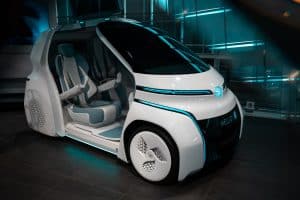Disruption is the underlying theme that unites the current global mobility scene. With the world turning to sustainable innovations, improved modes of transportation and accessibility are transforming industries and society alike. Since its inception, the automobile industry has been a focal point for technological, economic and social innovation.
The McKinsey Center for Future Mobility modelled more than 40 transportation use cases across a global mix of urban and highway settings under a range of technological, economic and other factors to better grasp the magnitude and scope of the AV opportunity.
Business model evolution
The outcomes of an AV-driven future are unquestionably favourable. Data, knowledge and understanding of the roadway layout, traffic patterns, human behavior, situational prediction, driving etiquette and meteorological information are key enablers for AVs.
The emergence of AVs in conjunction with the service-based economy has the potential to transform society and usher in a new era of mobility in which the value of asset ownership will be lower and the development of business models will be driven by convenience and user experience.
According to the Automobile Industry report by the Indian Brand Equity Foundation, India could be a leader in shared mobility by 2030, providing opportunities for electric cars and AVs.
The ability to entertain passengers will also become a more crucial component of product differentiation as drivers become less involved in vehicle operation. Today, there are numerous examples of audio entertainment incorporated into automotive systems (Tesla and Spotify, Pandora and various OEMs) and AVs can expand this to video entertainment (Netflix, TV), or productivity suites (Microsoft, Apple).
Emerging models
A new era of ‘NextGen mobility’, in which traditional ownership declines, is being ushered in by the growth of autonomy. The development of ride-sharing mobility models like Uber, which evolved from taxi services, is an important example of this shift to mobility as a developing model.
The capacity to maximize vehicle utilization to take advantage of in-the-moment demand is a crucial skill that serves as the basis for mobility potential models. Operators that use AV fleets can change their business models to meet the varying demands of their customers. For rental firms and other fleet operators with huge fleets, purchasing a completely autonomous fleet is expensive. The retrofit strategy is ideal, where new features or technologies are integrated into existing systems to increase functionality and efficiency or to conform to environmental requirements.
Autonomous mobility is enabling business transformation
While several major technology businesses are working to make self-driving technology a reality, many other sectors must adopt autonomous mobility, or they risk experiencing significant disruptions. Some industries that can gain from updating their business strategies are:
Auto parts and repairs: Smart driving software, such as brake assistance, will likely cause less damage to cars, which will need fewer replacements. AVs may not always be less expensive to maintain, though. Costs may merely move to computational power, which is where an AV’s value lies. More technologically-oriented businesses like Nvidia, which works with prominent automakers, will probably pose challenges to traditional component producers. Additionally, traditional repair shops will need to adopt modern technology like real-time diagnostics to give connected-car owners the ability to diagnose engine problems.
Telematics technology: Telecommunications-based communication and data collection from cars may allow driving-based service providers to switch to operating self-driving fleets that follow predetermined routes and carry out defined duties as efficiently as possible. Benefits from these systems are not guaranteed, however. The selection of the right operating model is crucial. These systems have the potential to reduce fleet management costs by up to 40%.
Ride-hailing companies: For their fleets, ride-hailing companies may collaborate with an AV developer, primarily continuing their current role as a middleman between individuals in need of transportation and those with available vehicles.
Healthcare: There is room for AV and major technology businesses to work together to create more seamless patient care experiences. Partnerships between pharmaceutical and AV technology firms have already been established to revolutionise distribution. CVS Health, for example, is exploring autonomous prescription delivery with Nuro. Such collaboration could be a gamechanger thanks to the greater dependability and efficiency of autonomous delivery.
Surveying and mapping: Safe AVs must have accurate self-positioning data as well as high-definition 3D digital maps to recognize their positions with accuracy. Keeping data updated with frequent changes in cities is a problem for mapping. Traditional maps with GPS-enabled navigation cannot be used in driverless automobiles. AI-enabled HD maps that combine and analyze data from various sources, including sensors, satellites, Lidar, onboard cameras and more are necessary for AV software. Companies may encounter additional challenges in collecting proprietary geospatial data, which is often protected by governments and private organisations. They also need to consider the high cost of HD mapmaking.
Urban planning: The real estate sector will undoubtedly experience disruption and change because of AV technology. Urban areas are being reimagined using AVs, which calls into question not only the buildings that should be constructed but also the significance of the land on which they stand. City planners and architects need to rethink their strategies if they want to create structures that will last for at least the next 100 years.
Auto dealerships: More riders might give up traditional automobile ownership models if fleets of AVs are made available, whether by automakers or through ride-hailing services. It’s possible that car ownership will move towards a subscription model in which a rental firm offers a car and all maintenance for a set price so that customers can access special features without having to make a commitment to purchase the vehicle.
These new developments, combined with encouraging government initiatives and laws, are expected to support the automotive industry’s expansion. The development of sustainable manufacturing techniques and the creation of job prospects within the industry can be aided by developing technology.
To give themselves enough time to position themselves positively, it is crucial for businesses to start thinking about the implications of these paradigm shifts right now. The essential insights can be obtained using a flexible model that considers different scenarios.







